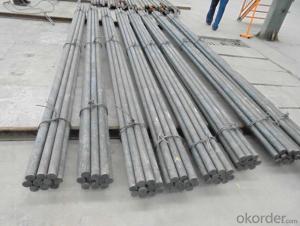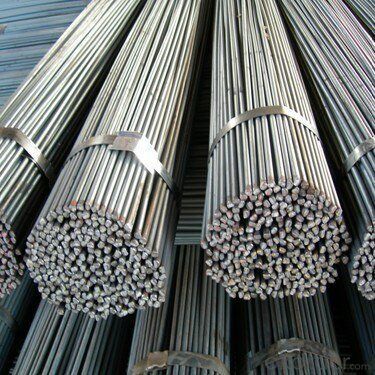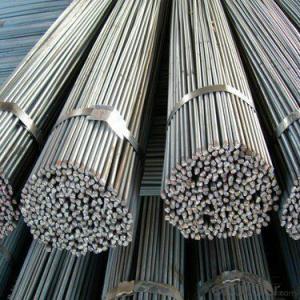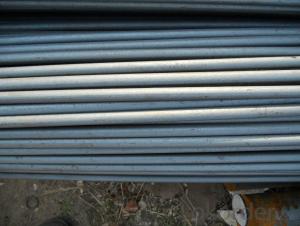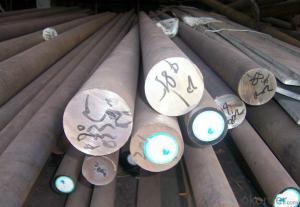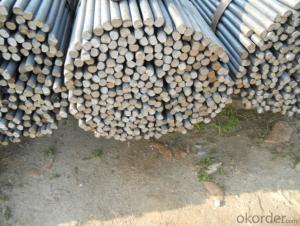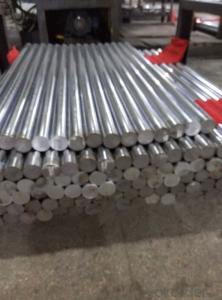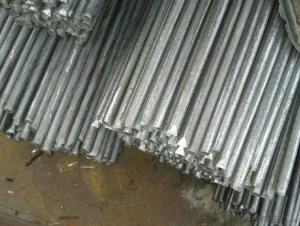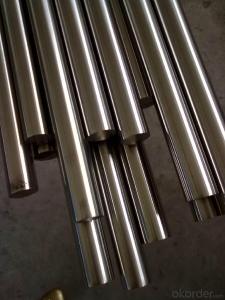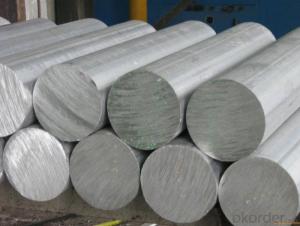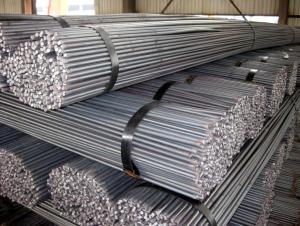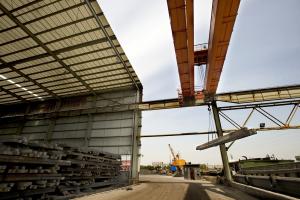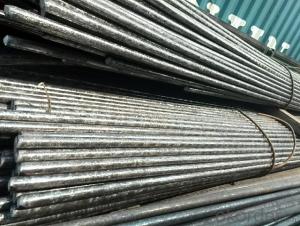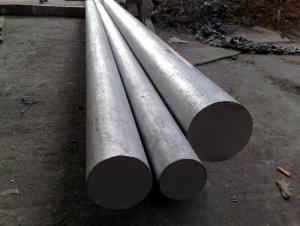Round Bar Chromed Steel Round Bar-Steel Round Bar Q235
- Loading Port:
- Tianjin
- Payment Terms:
- TT OR LC
- Min Order Qty:
- 25 m.t.
- Supply Capability:
- 20000 m.t./month
OKorder Service Pledge
OKorder Financial Service
You Might Also Like
Specification
Product Description:
OKorder is offering High quality Round Bar Chromed Steel Round Bar-Steel Round Bar Q235 at great prices with worldwide shipping. Our supplier is a world-class manufacturer of steel, with our products utilized the world over. OKorder annually supplies products to European, North American and Asian markets. We provide quotations within 24 hours of receiving an inquiry and guarantee competitive prices.
Product Applications:
Round Bar Chromed Steel Round Bar-Steel Round Bar Q235 are ideal for structural applications and are widely used in the construction of buildings and bridges, and the manufacturing, petrochemical, and transportation industries.
Product Advantages:
OKorder's Round Bar Chromed Steel Round Bar-Steel Round Bar Q235 are durable, strong, and resist corrosion.
Main Product Features:
· Premium quality
· Prompt delivery & seaworthy packing (30 days after receiving deposit)
· Corrosion resistance
· Can be recycled and reused
· Mill test certification
· Professional Service
· Competitive pricing
Product Description:
Specifications of High Quality Round Bar
1. Grade: GB, JIS, ASTM, EN
2. Grade: Q235, SS400, A36, S235JR
3. Diameter and mass: As below
Diameter | Mass | Diameter | Mass | Diameter | Mass |
(mm) | (kg/m) | (mm) | (kg/m) | (mm) | (kg/m) |
6 | 0.22 | 22 | 2.98 | 53 | 17.30 |
7 | 0.30 | 24 | 3.55 | 56 | 19.30 |
8 | 0.40 | 25 | 3.85 | 60 | 22.20 |
9 | 0.50 | 26 | 4.17 | 63 | 24.50 |
10 | 0.62 | 28 | 4.83 | 65 | 26.00 |
11 | 0.75 | 30 | 5.55 | 70 | 30.20 |
12 | 0.89 | 32 | 6.31 | 75 | 34.70 |
13 | 1.04 | 34 | 7.13 | 80 | 39.50 |
14 | 1.21 | 36 | 7.99 | 85 | 44.50 |
15 | 1.39 | 38 | 8.90 | 90 | 49.90 |
16 | 1.58 | 40 | 9.86 | 95 | 55.60 |
17 | 1.78 | 42 | 10.90 | 100 | 61.70 |
18 | 2.00 | 45 | 12.50 | 120 | 88.85 |
19 | 2.23 | 48 | 14.20 | 140 | 120.93 |
20 | 2.47 | 50 | 15.40 | 150 | 138.82 |
4. Material: Mild Steel
5. Heat treatment of high quality steel:
Fire: Isothermal annealing temperature is 800 ~ 880 °C, with 10 ~ 20 °C, the furnace cooling to about 600 °C, hardness above HB269.
Preheat temperature: 730-730 °C
Quenching temperature: 1190-1210 °C
Tempering temperature: 540-595 °C
Cold drawn, hardness 285 HBS
Cold drawn after annealing condition, hardness 277 HBS
Quenching methods: oil quenching, air cooling or salt bath quenching
Usage and Applications of High Quality Round Bar
1) Suitable for making various strong cutting tool abrasion resistance, impact resistance.
2) Used to produce all kinds of high hard and super hard saw blade, drill, tap, broach, gear hob and various kinds of milling cutter.
3) Used for advanced punching die, screw die, and the toughness and complicated shape of the punch, etc.
4) Is used for cold forging die and drawing mode, etc.
5) Recommended watchcase factory, screw factory and other cold stamping products industry use.
Packaging & Delivery of High Quality Round Bar
Packaging Detail: All goods are packed in bundle with steel strips and shipped by break bulk vessel or container (depend on target market and different ports)
Delivery Detail: 45 days
Trade terms: FOB, CFR, CIF
MOQ: 25 tons per specification; we can negotiate the quantity if the specification is normal or we have stock of one specification.
Weight: The price invoicing on theoretical weight basis or actual weight basis depends on customer’s request.
Shipment: The shipment of bulk break or container is depends on customer’s request and the situation of the port of destination.
Documents given: Full set of original clean on board bill of lading; Original signed commercial invoice; Original packing list; Policy of insurance; Certificate of origin and what the target market needs.
Production Flow of High Quality Round Bar
The common processes are preheated forging quenching, dual refinement solution process, cooling quenching and isothermal quenching. We use heat treatment for dual refinement solution process. The main measures process is high temperature solution and refinement cycle. High temperature solution can improve the carbide morphology and particle size. The aim is to make the loop refinement ultrafine austenite grains.
FAQ:
Q1: How soon can we receive the product after purchase?
A1: Within three days of placing an order, we will begin production. The specific shipping date is dependent upon international and government factors, but is typically 7 to 10 workdays.
Q2: How do we guarantee the quality of our products?
A2: We have established an advanced quality management system which conducts strict quality tests at every step, from raw materials to the final product. At the same time, we provide extensive follow-up service assurances as required.
Q3: What is the normal tolerance of Hot Rolled Mild Steel Angle Beams for Structures and for Buildings?
A3: Normally 3%-5%, but we can also produce the goods according to the customers' requests.
Images:
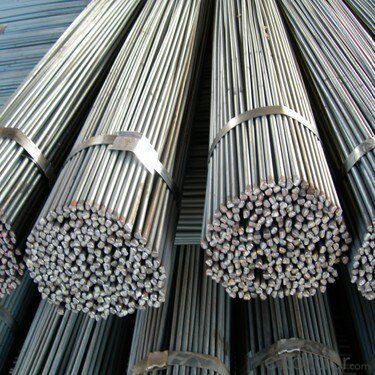

- Q: Are steel round bars susceptible to cracking?
- Cracking in steel round bars can occur under certain circumstances. Factors that contribute to cracking include high stress levels, improper heat treatment, and the presence of impurities or defects in the material. Cracking is also more likely with sudden temperature changes or excessive loading. It is worth noting that the susceptibility to cracking varies depending on the grade and composition of the steel. Low carbon or mild steel is generally less prone to cracking compared to higher carbon or alloy steels. To prevent cracking, it is crucial to handle and store steel round bars properly. This includes avoiding dropping or mishandling the bars and storing them in a dry, controlled environment to prevent corrosion. Proper heat treatment processes, such as annealing or tempering, can improve the structural integrity of steel round bars and reduce the risk of cracking. Regular inspections and testing for defects or impurities can help identify and address issues before they lead to cracking. In conclusion, while steel round bars can be susceptible to cracking, taking appropriate precautions and using proper manufacturing and handling techniques can minimize the risk and ensure the bars' integrity.
- Q: Can steel round bars be used in electrical applications?
- No, steel round bars are not typically used in electrical applications. Electrical conductors are typically made of materials that are good conductors of electricity, such as copper or aluminum. Steel is not as conductive as these materials and is more commonly used for structural purposes.
- Q: How do you calculate the shear strength of a steel round bar?
- In order to calculate the shear strength of a steel round bar, two pieces of information are required: the diameter of the bar and the shear modulus of the material. The shear strength is determined by dividing the maximum load that the bar can endure before shearing by its cross-sectional area. The shear strength can be calculated using the following formula: Shear Strength = Maximum Load / Cross-sectional Area To find the cross-sectional area, it is necessary to calculate the area of a circle using the diameter of the round bar. The formula for the area of a circle is as follows: Area = π * (Diameter/2)^2 Once the maximum load and cross-sectional area are known, these values can be substituted into the shear strength formula to determine the shear strength of the steel round bar. It is important to emphasize that the shear modulus is a crucial factor in the calculation process. The shear modulus indicates the material's resistance to deformation and measures the amount of shear stress that the material can withstand before it begins to deform. The shear modulus value can be obtained from reference materials or technical specifications provided by the manufacturer.
- Q: Can steel round bars be used in the shipbuilding industry?
- Steel round bars have a wide range of applications in the shipbuilding industry. They are commonly used for constructing hulls, decks, bulkheads, and other structural components. The reason for their popularity lies in their exceptional strength, durability, and resistance to corrosion, which makes them well-suited for withstanding the harsh marine environment. In terms of fabrication, steel round bars can be easily welded, machined, and formed according to desired shapes, offering flexibility in ship construction. Furthermore, their availability in various sizes and grades allows for customization to meet specific shipbuilding requirements. Ultimately, steel round bars play a vital role in the shipbuilding industry due to their robustness and reliability.
- Q: How are steel round bars used in the construction of dams and reservoirs?
- Steel round bars are commonly used in the construction of dams and reservoirs for reinforcement purposes. These bars are typically embedded within the concrete structures to enhance their strength and durability. The steel round bars act as a framework, providing structural integrity and preventing cracks or deformations in the concrete. This reinforcement ensures that the dam or reservoir can withstand the immense pressure and load exerted by the water, making them an essential component in the construction process.
- Q: Can steel round bars be galvanized?
- Indeed, it is possible to galvanize steel round bars. Galvanization is a technique that entails applying a protective zinc coating to the steel surface to prevent corrosion. This technique can be employed on various steel products, including round bars. By galvanizing steel round bars, not only is their resistance to corrosion enhanced, but also their durability and lifespan. The galvanization process entails immersing the round bars in a bath of molten zinc, which adheres to the steel and forms a protective layer. This layer serves as a barrier, safeguarding the steel from moisture, chemicals, and other corrosive elements. Consequently, galvanized steel round bars are extensively used in outdoor applications, such as construction, fencing, and marine environments, where they are exposed to harsh conditions.
- Q: Can steel round bars be used for making kitchen utensils?
- Yes, steel round bars can be used for making kitchen utensils. Steel is a strong and durable material that is commonly used in the production of kitchen utensils due to its resistance to corrosion, heat, and chemical damage. Steel round bars can be easily shaped and molded into various utensils such as spoons, forks, knives, and ladles. Additionally, steel utensils are non-reactive, which means they do not leach harmful substances into food, making them a safe choice for cooking and food preparation.
- Q: Are steel round bars suitable for marine environments?
- Yes, steel round bars can be suitable for marine environments, but it depends on the specific type of steel used and the conditions of the marine environment. Stainless steel is often the preferred choice for marine applications due to its excellent corrosion resistance properties. Stainless steel contains chromium, which forms a protective layer on the surface of the steel, preventing corrosion and rusting. However, not all steel round bars are suitable for marine environments. Carbon steel, for example, is more susceptible to corrosion in marine environments, especially in the presence of saltwater. Carbon steel should be carefully protected with coatings or treatments to prevent corrosion. Additionally, the conditions of the marine environment also play a significant role in determining the suitability of steel round bars. Factors such as the salinity of the water, exposure to chemicals, temperature variations, and physical stress can affect the corrosion resistance of steel. In highly corrosive marine environments, it is advisable to use specialized marine-grade stainless steel or other corrosion-resistant alloys. Ultimately, it is crucial to select the appropriate grade of steel and consider additional protective measures, such as coatings or galvanization, to enhance the durability and longevity of steel round bars in marine environments.
- Q: What is the tolerance for diameter and length of steel round bars?
- The tolerance for diameter and length of steel round bars can vary depending on the specific industry standards and requirements. In general, tolerances for diameter are typically specified in terms of a plus or minus deviation from the nominal diameter. For example, a tolerance of +/- 0.005 inches means that the actual diameter of the steel round bar can vary by up to 0.005 inches from the nominal diameter. Similarly, tolerances for length are also specified in terms of a plus or minus deviation from the nominal length. These tolerances can be expressed as a percentage or an absolute value. For instance, a tolerance of +/- 1% or +/- 0.5 inches means that the actual length of the steel round bar can vary by up to 1% of the nominal length or 0.5 inches, whichever is greater. It is important to note that different industries may have different tolerance requirements based on the specific applications and intended use of the steel round bars. Therefore, it is crucial to refer to the applicable industry standards or consult with the manufacturer or supplier to determine the exact tolerance specifications for diameter and length of steel round bars in a particular context.
- Q: Can steel round bars be used in high-temperature applications?
- Yes, steel round bars can be used in high-temperature applications. Steel is known for its strength and durability, and it can withstand high temperatures without deformation or loss of structural integrity. However, the specific type of steel and its composition will determine its suitability for high-temperature applications. Stainless steel, for example, has excellent heat resistance and can be used in a wide range of high-temperature environments. Additionally, certain alloy steels are specifically designed for use in high-temperature applications, such as those found in the aerospace or petrochemical industries. It is important to consult with experts and consider the specific requirements of the application to ensure the appropriate steel round bars are chosen for high-temperature conditions.
Send your message to us
Round Bar Chromed Steel Round Bar-Steel Round Bar Q235
- Loading Port:
- Tianjin
- Payment Terms:
- TT OR LC
- Min Order Qty:
- 25 m.t.
- Supply Capability:
- 20000 m.t./month
OKorder Service Pledge
OKorder Financial Service
Similar products
Hot products
Hot Searches
Related keywords
